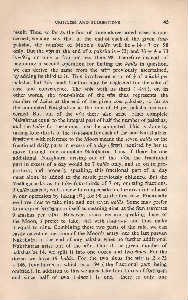Page 693 - Lokmanya Tilak Samagra (khand 2)
P. 693
CRITICISM AND SUGGESTIONS 45
result. Thus, so far as the first of three above-noted cases is con-
cerned, we may say that at the end of each of the given una-
paksha, the number of Moon's kahis will be = 14 x 7 or 98
only. But the <l~ at the end of a paksha is=73; and 73 + i x 73
is- 97-k or only a fraction less than 98. Therefore instead of
beginning a second operation for finding the kalas in question,
we can derive the same from the ~ previously ascertained,
by adding its third to it. This involves an error of i of a kala per
1>aksha; but this small fraction may be neglected for the sake of
ease and convenience. The ~ with its third ( .,~ ), or, in
other words, the four-thirds of the ~ thus represents the
number of kalds at the end of the given una-pakshas, so far as
the completed NaktJhatras at the rate of 14 per paksha are con-
cerned. But out of the <l~ll' there also arise other complete
NaktJhtras equal to the integral pa~ of half the number of pakshas;
and the kalas for these must also be computed. This is done by
taking four-thirds of the ~~111 for each of the said NaktJhatras.
~~4l!11 with reference to the Moon means the seven kalas or the
fractional daily parts in excess of a day (R<ffi) required by her to
move through one complete Nakthatra. Thus, if there be one
additional Nak~hatra arising out of the ~. the fractional
part in excess of a day would be 7 kalas only, and so on in pro-
portion; and properly speaking, this fractional part of a day
must alone be added to the result previously obtained. But the
Vedanga asks us to take four-thirds of 7 or, omitting fractions,
9 kalds instead, with a view to compensate for the error introduced
in our operation by taking 97 ~ for 98 in the first case. Practically
we have thus to take nine and not seven kalas. Some may prefer
to interpret ~~ in itself as meaning nine, as the Sun traverses
9 amshas per tithi. However, since we are speaking here of
the Moon, I prefer to take, ~ with ~<t6i~~l11 and thus make
it equal to nine. Combining these two parts of the rule, we can
easily calculate the time of the Moon's entry into the last parvan
Naktllhatra at the end of any paksha, when no further additional
Nakehatras arise out of the <l~. Thus if the given number of
pakshas be 14, we split it into one dozen and two tmas. For the
dozen we have 19 kalas. For the two ~/,nas the ~ is 2 x 73
= 146, four-thirds. of which is = 194 (the fractional part being
omitted). In addition to this we must take four-thirds of ~111
and since half of two ( unas) is one, there is only one

